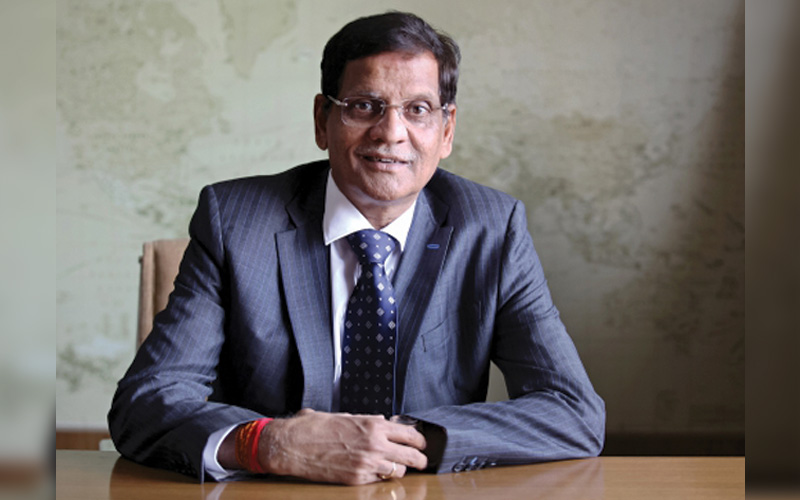Since its inception in 1965, RR Kabel has been pursuing simpler ideas for better living. The company has been at the forefront of the evolution of solar cables. Its comprehensive solar product portfolio includes DC solar cables compliant with various national and international standards, connecting photovoltaic arrays to inverters and battery banks. It also offers innovative floating solar cables for submerged installations. “Investments in E-Beam technology have enhanced our solar cables’ durability and reliability, making us a preferred market choice,” says Mr. Shreegopal Kabra, the company’s Managing Director during an interaction with Wire & Cable India.

Wire & Cable India: How much has the Indian solar wire and cable segment evolved over the years, and how are you positioned as a manufacturer in it?
Shreegopal Kabra: The Indian solar wire and cable segment has transitioned from a nascent industry to a crucial component of the renewable energy sector. This growth aligns with India’s ambitious solar energy targets, which have driven demand for high-quality, reliable solar cables. As a manufacturer, RR Kabel has been at the forefront of this evolution. We were among the first Indian companies to secure BIS approval IS 17293 for DC solar cable. Our products exceed global standards like EN 50618 and comply with IEC 62930. Investments in E-Beam technology have enhanced our solar cables’ durability and reliability, making them a preferred market choice. This positions us strongly in a rapidly growing sector, where India’s solar power capacity has reached 73 GW, ranking fifth globally in installed power capacity. The dramatic increase in solar generation, from 0.5 percent of India’s electricity in 2015 to 17 percent in 2023, underscores the industry’s potential and our strategic position within it.
WCI: How significant is the solar segment for you? Please take us through your solar product portfolio.
SK: The solar segment is not just a business opportunity for us; it is a commitment to supporting the global transition to renewable energy. By providing innovative, reliable, and sustainable solar cables, we play a crucial role in enabling the growth of solar power and contributing to a cleaner, greener future. Our comprehensive solar product portfolio includes DC solar cables compliant with various national and international standards, connecting photovoltaic arrays to inverters and battery banks. We also offer innovative floating solar cables for submerged installations. Our range encompasses LT power cables for panel-to-combiner, combiner-to-inverter, and inverter-to-transformer connections, as well as HT power cables for substation and grid connections. Additionally, we provide control and data cables crucial for real-time performance monitoring and system control. All our products are designed to withstand harsh environmental conditions, ensuring longevity and optimal performance in diverse settings including indoor, outdoor, hazardous areas, industrial environments, and agricultural applications. This extensive portfolio positions us strongly in the rapidly growing solar power sector, meeting the diverse needs of solar installations across various scales and environments.
Watch: RR Kabel | Solar Cables | Solar Plant | Renewable Energy
WCI: Based on end-users, such as residential, industrial and commercial, where do your solar cables experience more demand? Why?
SK: Our solar cables experience the highest demand in the industrial and commercial sectors. This is primarily because these sectors have larger-scale installations that require robust and reliable cabling solutions to ensure efficiency and safety. Industrial and commercial solar projects are substantial investments, emphasizing the importance of high performance and longevity of the cables. However, with the increasing adoption of solar power in residential areas, we are also seeing a growing demand in this segment. This rise is driven by the push towards sustainable energy solutions and the cost savings on electricity that solar power offers. Our diverse product range is designed to meet the needs of all these sectors, providing durable and efficient solutions for any scale of installation.
WCI: Where in the country do your products enjoy strong demand? Please elaborate why.
SK: Our products enjoy strong demand across various regions in India, particularly in states with high solar energy potential such as Rajasthan, Gujarat, Tamil Nadu, and Maharashtra. These states have favorable climatic conditions for solar power generation and proactive government policies supporting renewable energy projects. Additionally, regions with significant industrial activity and large commercial establishments also exhibit strong demand for our solar cables due to their extensive energy requirements and the shift towards sustainable energy solutions. The combination of abundant sunlight, supportive government incentives, and the increasing emphasis on sustainability in both industrial and commercial sectors drives the demand for our high-performance solar cables, making us a preferred choice in these regions.
WCI: What technologies have you incorporated into your manufacturing facilities to produce solar wire and cable? How unique are they?
SK: Our cutting-edge manufacturing utilizes advanced technologies, including a state-of-the-art E-Beam facility. This innovative process uses irradiation to significantly enhance the durability and reliability of our solar wires and cables. Further, it ensures our products are halogen-free and can withstand adverse environmental conditions for a minimum lifespan of 25 years, seamlessly aligning with the typical duration of solar projects. Our manufacturing leverages advanced automation and integrated quality control systems to ensure consistent precision and unwavering adherence to international standards. This meticulous approach guarantees each solar cable surpasses performance criteria, fostering exceptional reliability in even the most demanding applications. These technological investments set us apart in the industry. The E-Beam technology, in particular, is relatively unique and provides our cables with superior performance characteristics.
WCI: Compared to other wire and cable, how different is the manufacturing process of solar wire and cables?
SK: Solar cables must withstand extreme environmental conditions, including intense UV radiation, wide temperature fluctuations, and high moisture levels, often for decades. To meet these challenges, we use specialized materials and advanced manufacturing techniques. Our solar cables are made with halogen-free compounds, which enhance safety and environmental friendliness. A key differentiator in our process is the use of E-Beam irradiation technology. This advanced treatment significantly enhances the cables’ durability and performance characteristics, ensuring they can withstand harsh conditions throughout their extended lifecycle. Our manufacturing process also involves higher precision and more rigorous quality control measures compared to standard cable production. We employ stringent testing protocols to verify the cables’ ability to perform reliably over their entire lifespan, which is crucial for the long-term success and efficiency of solar power systems.
WCI: How sustainable are your products? Please explain the process you have adopted to achieve it?
SK: Our solar cables are engineered for a life expectancy of at least 25 years, significantly outperforming traditional PVC-based cables in the Indian market. This longevity ensures improved solar plant efficiency and reduces environmental impact over time. We use special halogen-free materials in our cables, minimizing environmental impact throughout their lifecycle and preventing the release of harmful substances. Our E-Beam irradiation process further enhances cable durability, reducing the need for replacements and minimizing waste generation. Our manufacturing processes adhere to strict environmental regulations and standards. We offer our cables with REACH and RoHS compliances, ensuring they are free from over 240 hazardous substances. This commitment extends beyond the product to encompass our entire production ecosystem. By focusing on longevity, using environmentally friendly materials, and adhering to stringent environmental standards, our products not only support sustainable energy generation but also embody sustainability in their own right.
WCI: Given India’s ambitious 500GW renewable energy target and solar wire and cable being the lifelines of the solar power system, what kind of growth prospects are you staring at?
SK: As of May 2024, India’s installed renewable energy capacity stands at 193.57 GW, with solar power contributing 84.27 GW. This leaves a significant gap to be filled in the coming years, presenting immense opportunities for the solar cable industry. As a leading manufacturer, we are well-positioned to capitalize on this growth. The surge in solar power installations will drive significant demand for high-quality cabling solutions, which are critical to the efficiency and longevity of solar power systems. Our investment in advanced technologies, such as E-Beam irradiation, and adherence to global standards ensure that our products are ready to meet this increasing demand. With India’s commitment to reduce carbon intensity and achieve net-zero emissions by 2070, the solar sector is poised for exponential growth, directly benefiting the solar cable industry.
Also Read: APAR Sees Great Potential for Solar Cables in Indian, US Markets
WCI: Discuss some of the major challenges you have been experiencing as a manufacturer in the industry. What could help overcome them?
SK: As a manufacturer in the solar wire and cable industry, one of our major challenges is the influx of low-quality, price-competitive products that fail to meet required technical standards. These substandard products can compromise the performance and safety of solar power systems, leading to failures and increased maintenance costs. Every kilowatt lost in generation due to poor quality cables represents a significant loss in return on investment. To address this challenge, the Ministry of Commerce has recently released a Quality Control Order (QCO) mandating the manufacture and use of only IS 17293 marked DC solar cable in India. The Bureau of Indian Standards (BIS) has taken major steps to enforce these stringent quality standards and regulations for DC solar cables. Additionally, we believe that raising awareness among stakeholders about the importance of high-quality solar cables is crucial. Educating the market on the long-term benefits and cost savings associated with reliable cabling solutions can drive demand for quality products and support the industry’s growth. This approach can help overcome the challenge of substandard products and enhance overall industry standards.





